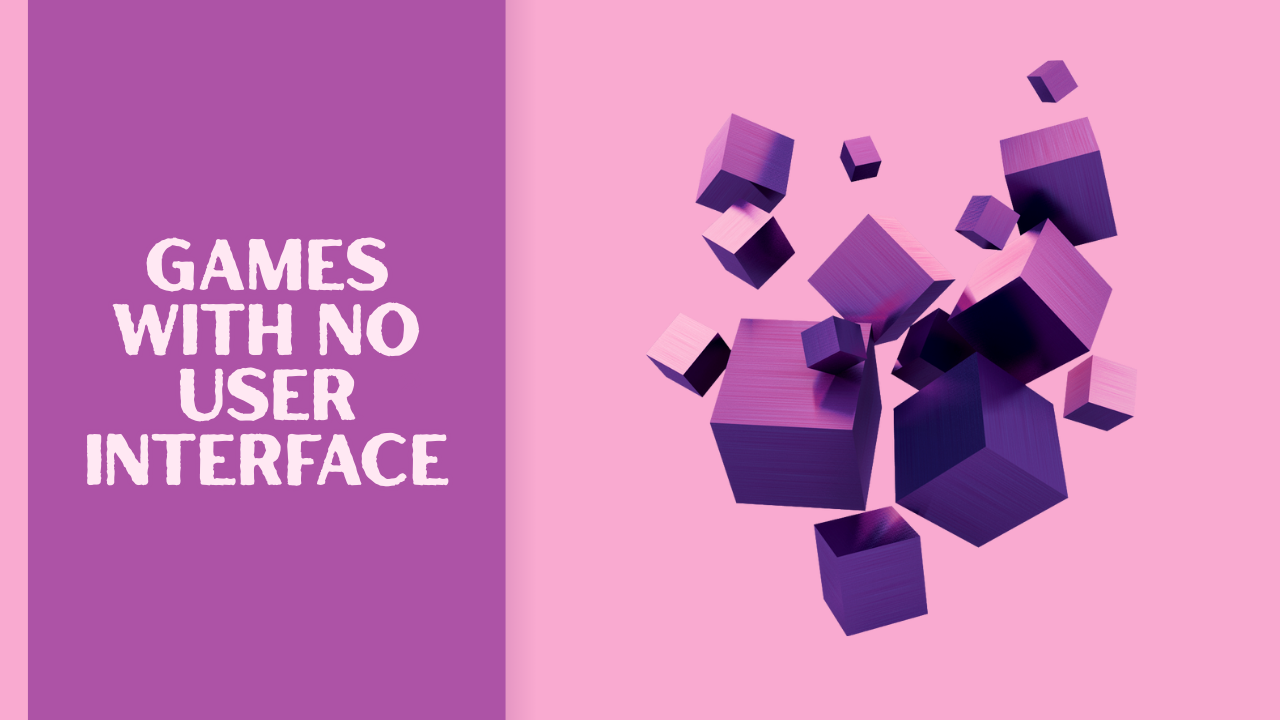In the realm of video games, the user interface (UI) has traditionally been a crucial element, providing players with essential information such as health stats, inventory, and objectives. However, a growing trend in game design challenges this norm by creating experiences that forgo conventional UIs. These games immerse players in environments where interaction and understanding are conveyed through context, sound, and exploration, rather than through on-screen indicators.
Understanding Games Without a User Interface
A game without a user interface eliminates traditional HUD elements like health bars, maps, and menus. Instead, it relies on alternative methods to communicate gameplay information. This design philosophy emphasizes immersion, encouraging players to engage more deeply with the game world and their surroundings.
Key Characteristics
- Environmental Storytelling: The game world itself conveys narrative and gameplay elements. Players learn about the story and mechanics through exploration and interaction with the environment.
- Audio Cues: Sound plays a pivotal role in guiding players. In some games, binaural audio cues replace visual indicators, providing spatial awareness and context.
- Minimalist Design: The absence of a UI leads to a cleaner, more focused experience, where the player’s attention is directed solely at the game world and their actions within it.
Notable Examples of UI-less Games
Several games have embraced this minimalist approach, offering unique and engaging experiences.
1. Papa Sangre
Papa Sangre is a horror-themed audio game developed for iOS devices. It is described as a “video game with no video,” utilizing binaural audio to create a fully immersive experience. Players navigate a dark and eerie world using only sound, relying on auditory cues to locate objects and avoid dangers. This design choice enhances the horror atmosphere, making every sound a potential clue or threat.
2. Strawberry Cubes

3. Mu Cartographer
Mu Cartographer is a visual exploration game that challenges players to navigate and map an abstract world without explicit instructions. The game uses shaders and visual effects to guide players, encouraging them to learn the mechanics through experimentation. This approach fosters a sense of discovery and personal achievement as players uncover the game’s secrets.
4. Islands: Non-Places
In Islands: Non-Places, players click on various parts of the environment to trigger scenes that unfold in real-time. There are no puzzles to solve or overarching narrative goals; the game is an exploration of mundane, often overlooked spaces. The lack of a UI directs players’ focus to the beauty and strangeness of the environments themselves, turning everyday locations into surreal experiences.
5. Samorost
Created by Amanita Design, Samorost is a point-and-click adventure that features a gnome traveling through surreal landscapes to prevent a collision between planets. The game uses whimsical art and ambient sound to tell its story, with minimal text and no traditional UI elements. The focus is on exploration and interaction with the environment, creating a dreamlike experience.
The Philosophy Behind UI-less Games

The design of games without user interfaces is rooted in a desire to create more immersive and intuitive experiences. By removing traditional UI elements, developers encourage players to engage more deeply with the game world and to rely on their senses and intuition.
Enhancing Immersion
Without the distraction of on-screen indicators, players can become more attuned to the game’s atmosphere and narrative. This heightened sense of immersion can lead to a more emotionally resonant experience, as players are not constantly reminded that they are playing a game.
Encouraging Exploration
In the absence of explicit instructions or objectives, players are often compelled to explore their surroundings and experiment with different actions. This sense of curiosity and discovery can lead to a more personalized and satisfying gameplay experience.
Promoting Intuition
UI-less games often require players to learn the game’s mechanics through observation and experimentation, rather than through tutorials or on-screen prompts. This approach can lead to a deeper understanding of the game and a greater sense of accomplishment when players figure things out on their own.
Challenges and Considerations

While the design of games without user interfaces offers unique benefits, it also presents certain challenges.
Accessibility
The lack of visual indicators can make these games difficult to navigate for players with visual impairments. Developers must consider alternative methods, such as audio cues or tactile feedback, to ensure that all players can enjoy the game.
Learning Curve
Without traditional tutorials or UI elements, players may find it challenging to understand the game’s mechanics initially. This can lead to frustration, especially for those accustomed to more conventional game designs.
Balancing Minimalism and Clarity
Striking the right balance between minimalism and clarity is crucial. While the absence of a UI can enhance immersion, it should not come at the expense of player understanding. Developers must ensure that players can still comprehend the game’s objectives and mechanics without explicit instructions.
Future Trends in UI-less Game Design
The success of games without user interfaces has inspired a growing interest in minimalist game design. Future developments may include:
- Advanced Audio Technologies: The use of spatial audio and haptic feedback could further immerse players in UI-less games, providing additional layers of interaction and sensory input.
- Procedural Generation: The creation of dynamic, ever-changing game worlds could offer unique experiences in each playthrough, encouraging repeated exploration without the need for traditional UI elements.
- Collaborative Gameplay: Multiplayer experiences that rely on shared understanding and communication, rather than on-screen indicators, could foster deeper social interactions and cooperation among players.
FAQs
1. What is a UI-less game?
A UI-less game is one that does not display traditional user interface elements, such as health bars, maps, or menus. Instead, it conveys gameplay information through alternative methods like environmental cues, audio, and exploration.
2. Are UI-less games suitable for all players?
While UI-less games can offer unique and immersive experiences, they may not be suitable for all players. Some individuals may find the lack of traditional UI elements challenging, especially if they rely on visual indicators to navigate and understand the game.
3. How do UI-less games convey information?
UI-less games often use environmental storytelling, audio cues, and intuitive design to convey information. Players learn about the game world and mechanics through observation, interaction, and exploration, rather than through explicit instructions or on-screen indicators.
4. Can UI-less games be played without prior experience?
Many UI-less games are designed to be intuitive and encourage learning through experimentation. However, players without prior experience in minimalist game design may face a steeper learning curve and may need to invest more time in understanding the game’s mechanics.
5. What are the benefits of playing UI-less games?
Playing UI-less games can enhance immersion, encourage exploration, and promote intuitive learning. These games often provide a more organic and personalized gameplay experience, as players are not guided by traditional UI elements.
Conclusion
Games without user interfaces represent a bold and innovative approach to game design. By removing traditional UI elements, these games emphasize immersion, discovery, and emotional engagement. They challenge players to think differently, to learn through doing, and to engage with game worlds in more natural, intuitive ways. Whether through sound-based navigation, environmental cues, or surreal minimalist aesthetics, UI-less games have proven that compelling gameplay doesn’t require cluttered screens or guided instructions.
This genre isn’t just a novelty—it’s part of a broader movement in game development that prioritizes artistic expression, experimentation, and player agency. It invites a rethinking of what a “game” should look like and opens doors for developers who want to create unique experiences that feel more like interactive art than traditional video games.
